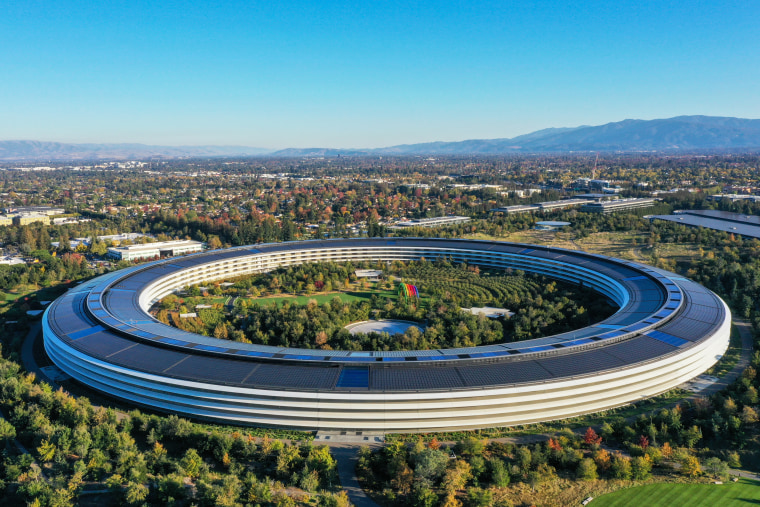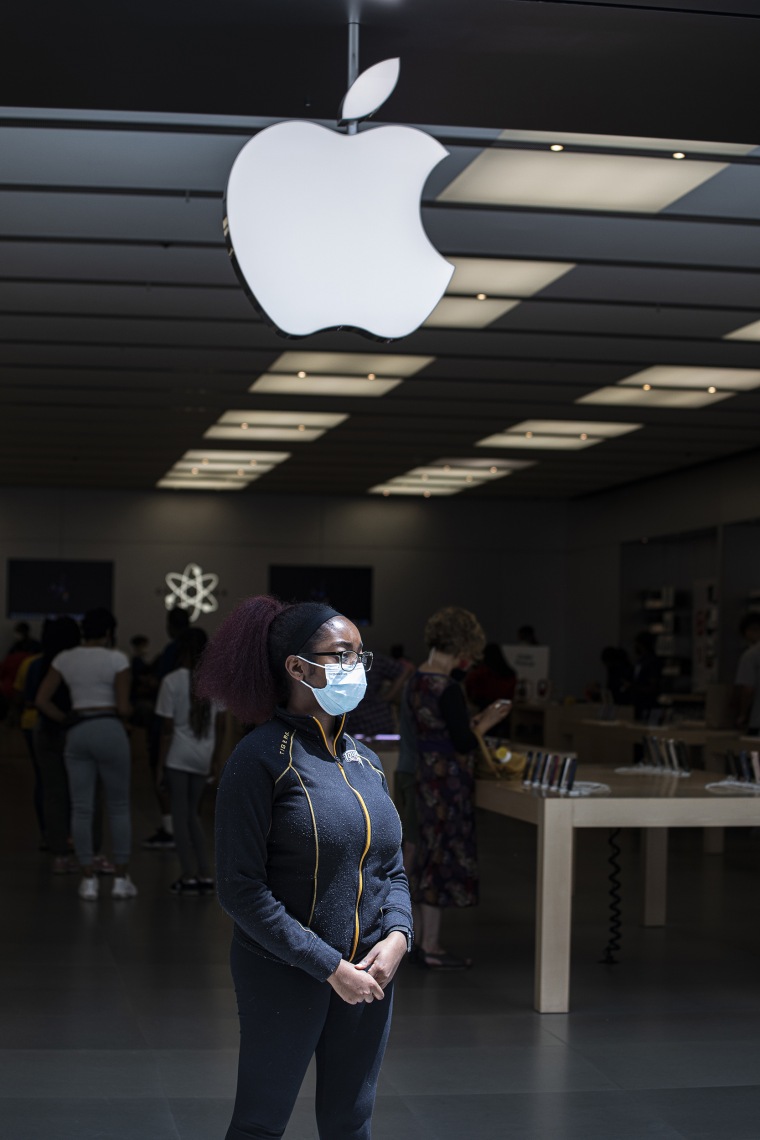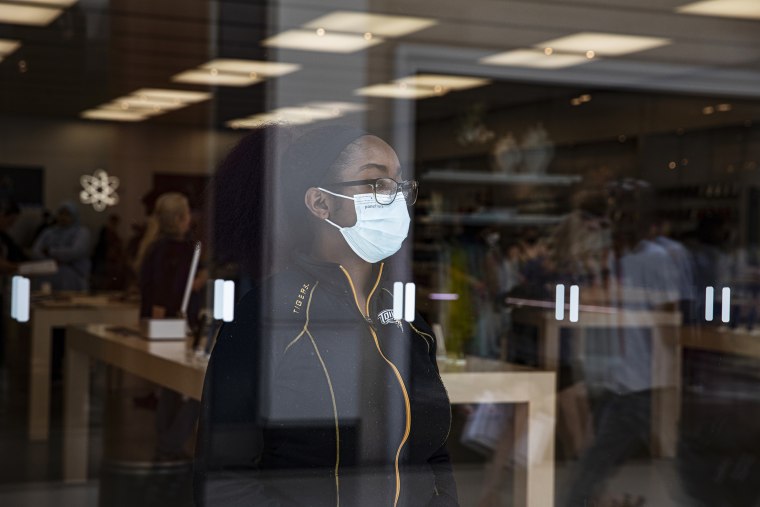Whenever Noah McCool pitches his co-workers at their Apple store in Nashville, Tenn., on why they should form a union, he focuses on the money. He tells them how much the average Apple store has brought in per worker historically — in the hundreds of thousands of dollars, he says — and then notes that many of the store workers’ annual salaries hover around $46,000, an amount calculated from the company’s new minimum wage.
“It’s a compelling argument for organizing,” said McCool, 24, a store specialist. “People are immediately like, ‘You’re right. We should be getting paid more.’”
Discussions like these are happening at Apple stores around the U.S., from New York to Kentucky, as a national wave of organizing sparked by the pandemic has come to one of the world’s most valuable companies.
This week, workers at an Apple store in Towson, Maryland, became the first at the company to vote to join the International Association of Machinists and Aerospace Workers union. The count began June 15 and the result was made public on Saturday.
While many Apple workers acknowledge that the company offers above average wages for the typically low-paying retail sector and benefits like health care and parental leave that set it apart from other competitors, they still question whether they are getting paid fairly.
The company doesn’t release its average pay for retail workers, but it recently announced its minimum wage will rise to $22 an hour in July — roughly in line with the mean hourly wage for electronics retail workers, which was $20.85 in 2021, according to federal data.
A dozen employees, 10 current and two former, said in interviews for this story that questions about pay were driving the organizing efforts. Those questions center on equity, transparency and whether profits at what recently was the world’s first $3 trillion company were being shared evenly with its frontline workers.
“We just went through a pandemic that incredibly, disproportionately affected the poorest communities and minority communities. And in that same amount of time, the wealthiest individuals in America added a whole another trillion dollars to their wealth,” said Derrick Bowles, 37, an Apple worker in Atlanta who is helping to organize the Cumberland Mall store.
“We got to see ourselves going back to work having to wear masks and stand behind Plexiglas while we talk to customers and stuff, while our VPs and CEOs got to safely and securely work from home.”
Historically, unions provided a pathway to the middle class for many Americans. But as unions have shrunk in number over the last half-century, academics see another phenomenon, tracing the sharp rise in income inequality to their decline.
“The historical evidence suggests that unions help reduce income inequality,” said Henry Farber, an economics professor at Princeton, who was the lead author of a recent study that found that the growth of unions in the aftermath of the Great Depression resulted in significant declines in income inequality. “The evidence also suggests that unions raise wages for less skilled workers, people at the bottom of income distribution more than people at the top, so they have a natural equalizing effect.”
Organizing at Apple, which employs some 65,000 retail workers, is unlikely to make a dent in that on a wide scale. But at a tech company with such a large international profile, a union victory at Apple could ring particularly loud.
Paying for it
Compensation at Apple has long been a hot topic, as the company has had the world’s highest market value for much of the past decade. During the pandemic, the company’s value surged even further, as it became the first $3 trillion company at the end of 2021. That’s triple the figure from as recently as 2018. Its revenue has also soared, to $365 billion at the end of its 2021 fiscal year, up from $274 billion the year before, according to its financial statements.

But though wages have increased steadily at Apple, they have not been rising at that same pace. Its minimum wage — $46,000 a year on a full-time schedule — has gone up 45% since 2018, according to statements the company gave news outlets.
Some workers have begun to create spreadsheets to anonymously share salaries with co-workers. But those efforts have occasionally caused friction.
Former software engineer Cher Scarlett resigned in 2021 after creating such a survey for Apple’s corporate employees. She said her spreadsheet received more than 3,000 salary entries from her colleagues and demonstrated evidence of gender pay gaps on some teams.
Scarlett currently has a pending complaint with the National Labor Relations Board in which she alleges the company squashed her push for salary transparency, for which workers have legal protection. Her complaint claims that leadership at the company “engaged in coercive and suppressive activity that has enabled abuse” of workers organizing around issues like pay. It also says the company prevented her and a colleague from creating a public channel on Slack to discuss pay equity.
“What they were trying to do was stop us from organizing around any issue,” Scarlett said. “Pay is the biggest reflection of how people are treated in a workplace.”
Apple declined to comment on Scarlett’s allegations or case, but said it had “achieved and maintained” gender pay equity for its employees worldwide since 2017.
“In the U.S., we have also achieved pay equity with respect to race and ethnicity — as well as pay equity at the intersections of race and ethnicity with gender,” the company said in a statement distributed by spokesman Josh Lipton.
For its retail workers, another informal salary spreadsheet has been circulating since April, after a former manager at the Apple store in Brooklyn, New York, Sidney Lo, created one that went viral on LinkedIn.
Lo said he started the sheet because as a manager who was involved in hiring, he saw firsthand how the company’s pay system created inequities, like paying a new hire just as much as a longtime employee.
“The structures created a lot of inequality,” he said. “What I took away from my time at Apple doing salaries was the fair market rate often did not match the changing environment like it should have been. … You’re losing to inflation, cost of living increases, the market changing, and the only way you would know is through pay transparency.”
Another statement sent by Lipton said that the company deeply valued its workers.
“We are pleased to offer very strong compensation and benefits for full time and part time employees, including health care, tuition reimbursement, new parental leave, paid family leave, annual stock grants and many other benefits,” the statement said.
A larger slice
The Communications Workers of America, the union with which Apple store workers in Atlanta, Louisville, Nashville, New York and other cities are organizing, estimates that the company’s revenue per retail employee ranges from between $545,000 and $610,000, based on a review of its financial statements. Many workers are talking about the statistic — and using it to argue that they deserve to earn more.
“To me that pay thing is all over the place, like, doesn’t seem like it matters, how long have you been with a job, it doesn’t matter what your skill set is,” said Tiawana Dugger, 24, who makes about $26 an hour at the Apple store in Towson.
Employees who are working to unionize the Grand Central station store in New York have asked for a minimum wage of $30 an hour.

Jay Hedgspeth, 20, a student and worker who is leading a union drive at an Apple store in Louisville, Kentucky, says he struggles to pay his bills on the $20 an hour he currently makes at the company working 20 to 30 hours a week.
Hedgspeth supplements his Apple income with revenue from streaming games on Twitch, where he said he spends about 10 to 15 hours a week, and from an additional five or more hours a week he puts in at a production company. Despite all that, he still finds it hard to keep up with his regular expenses, which are about $1,650 a month for his tuition and housing, another $400 a month for his car and insurance, and other costs like food and recreation, he said.
The $2 an hour minimum wage increase, which goes into effect next month, will help cover the increased cost of gas, he said, but not much else.
He said a company like Apple should share more of its wealth.
“Especially compared to the vast majority of other companies, Apple is almost uniquely poised to be able to actually do something about it,” he said, citing the fact that the company spent $85 billion on stock buybacks last year, which works out to be roughly $500,000 for every one of the 154,000 people who work for Apple worldwide.
“We think that asking for transparency around pay inequality, and cost of living adjustments in real living wages isn’t that crazy of a thing to ask. It increasingly feels like there’s two Apples. There’s the corporate side in Cupertino, and then there’s the retail Apple.”
